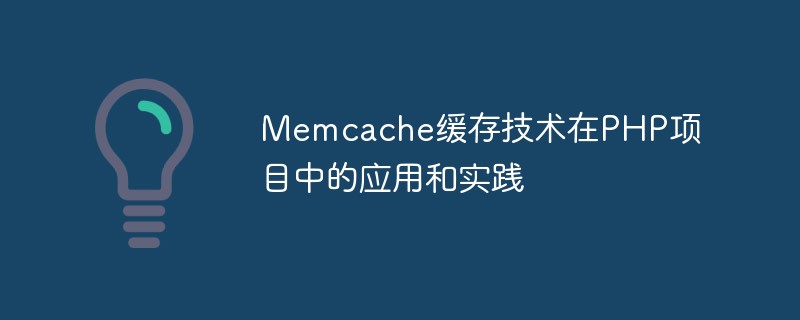 Backend Development
Backend Development Python Tutorial
Python Tutorial How to improve the static resource access speed of Python website through caching technology?
How to improve the static resource access speed of Python website through caching technology?How to improve the static resource access speed of Python website through caching technology?
With the development of the Internet, website access speed has become more and more important. For Python websites, using caching technology is a common method to improve website performance. Caching can reduce the number of database queries, reduce server load, and improve user experience. This article will introduce how to improve the static resource access speed of Python websites through caching technology, and provide code examples.
- Using caching libraries
Python has many excellent caching libraries, such as Redis, Memcached, etc. These libraries provide fast, scalable caching services. These libraries can be installed using pip and referenced in your code.
Sample code:
import redis
# 连接Redis缓存
cache = redis.Redis(host='localhost', port=6379)
# 保存数据到缓存
cache.set('key', 'value', ex=3600)
# 从缓存中获取数据
data = cache.get('key')
print(data)- Caching static resources
Static resources include pictures, style sheets, JavaScript files, etc. Since the content of static resources does not change frequently, caching technology can be used to improve their access speed. You can use a caching library to store static resources and set appropriate expiration times.
Sample code:
import redis
import hashlib
# 连接Redis缓存
cache = redis.Redis(host='localhost', port=6379)
# 生成静态资源的缓存键
def generate_cache_key(url):
return 'static:' + hashlib.md5(url.encode('utf-8')).hexdigest()
# 从缓存中获取静态资源
def get_static_resource(url):
cache_key = generate_cache_key(url)
data = cache.get(cache_key)
if data:
return data
else:
# 从文件系统或远程服务器获取静态资源
data = fetch_static_resource(url)
cache.set(cache_key, data, ex=3600)
return data
# 从文件系统或远程服务器获取静态资源
def fetch_static_resource(url):
# ...
pass
# 使用缓存获取静态资源
data = get_static_resource('http://example.com/static/image.jpg')
print(data)- Cache view function
The view function handles the user's request and returns the response. You can use caching technology to cache the results of view functions to avoid executing the same logic on every request. Decorators can be used to implement the functionality of caching view functions.
Sample code:
import redis
from flask import Flask
from functools import wraps
app = Flask(__name__)
cache = redis.Redis(host='localhost', port=6379)
# 缓存视图函数的装饰器
def cached(timeout=3600):
def decorator(f):
@wraps(f)
def wrapper(*args, **kwargs):
cache_key = generate_cache_key(request.url)
data = cache.get(cache_key)
if data:
return data
else:
data = f(*args, **kwargs)
cache.set(cache_key, data, ex=timeout)
return data
return wrapper
return decorator
# 示例视图函数
@app.route('/hello')
@cached()
def hello():
return 'Hello, World!'
# 运行Flask应用
if __name__ == '__main__':
app.run()Through caching technology, the static resource access speed of Python websites can be significantly improved. Using appropriate caching libraries, caching static resources, and caching view functions can improve the performance of your website and provide a better user experience. In practical applications, it can be further optimized through reasonable caching strategies and cache invalidation mechanisms.
The above is the detailed content of How to improve the static resource access speed of Python website through caching technology?. For more information, please follow other related articles on the PHP Chinese website!
 Memcached缓存技术对于PHP中的Session处理的优化May 16, 2023 am 08:41 AM
Memcached缓存技术对于PHP中的Session处理的优化May 16, 2023 am 08:41 AMMemcached是一种常用的缓存技术,它可以使Web应用程序的性能得到很大的提升。在PHP中,常用的Session处理方式是将Session文件存放在服务器的硬盘上。但是,这种方式并不是最优的,因为服务器的硬盘会成为性能瓶颈之一。而使用Memcached缓存技术可以对PHP中的Session处理进行优化,提高Web应用程序的性能。PHP中的Session处
 如何通过数据库优化提高Python网站的访问速度?Aug 07, 2023 am 11:29 AM
如何通过数据库优化提高Python网站的访问速度?Aug 07, 2023 am 11:29 AM如何通过数据库优化提高Python网站的访问速度?摘要在构建Python网站时,数据库是一个关键的组成部分。如果数据库访问速度慢,会直接影响网站的性能和用户体验。本文将讨论一些优化数据库的方法,以提高Python网站的访问速度,并附有一些示例代码。引言对于大多数Python网站来说,数据库是存储和检索数据的关键部分。如果不加以优化,数据库可能成为性能瓶颈。本
 利用Memcached缓存技术对于PHP中的音视频播放进行优化May 17, 2023 pm 04:01 PM
利用Memcached缓存技术对于PHP中的音视频播放进行优化May 17, 2023 pm 04:01 PM随着互联网技术的不断发展,音视频资源已经成为了互联网上非常重要的一种内容形式,而PHP作为网络开发中使用最广泛的语言之一,也在不断地应用于视频和音频播放领域。然而,随着音视频网站的用户日益增加,许多网站已经发现了一个问题:在高并发的情况下,PHP对于音视频的处理速度明显变缓,会导致无法及时播放或者播放卡顿等问题。为了解决这个问题,Memcached缓存技术应
 如何通过网络优化提高Python网站的访问速度?Aug 04, 2023 pm 07:15 PM
如何通过网络优化提高Python网站的访问速度?Aug 04, 2023 pm 07:15 PM如何通过网络优化提高Python网站的访问速度?摘要:随着互联网的普及,网站的访问速度成为了用户体验的一个关键因素。本文将介绍一些通过网络优化来提高Python网站访问速度的方法,并提供一些代码示例。使用CDN加速:内容分发网络(CDN)是一种通过将网站内容分发到全球各地的服务器上来提高访问速度的技术。使用CDN可以减少网络延迟、增加带宽和吞吐量等。下面是使
 PHP开发:使用缓存技术优化代码性能Jun 15, 2023 pm 02:39 PM
PHP开发:使用缓存技术优化代码性能Jun 15, 2023 pm 02:39 PMPHP是一种脚本语言,常用于Web应用程序开发。随着互联网的迅速发展,Web应用程序的开发也变得越来越复杂,代码量越来越大。因此,优化代码性能变得尤为重要,在这方面,使用缓存技术是一种行之有效的方式。在本文中,我们将探讨PHP开发中使用缓存技术优化代码性能的方法和技巧。什么是缓存技术?首先,让我们了解一下什么是缓存技术。在计算机中,缓存是一种临时存储数据的技
 Memcache缓存技术在PHP项目中的应用和实践May 17, 2023 pm 02:10 PM
Memcache缓存技术在PHP项目中的应用和实践May 17, 2023 pm 02:10 PMMemcache是一种开源的、分布式的缓存技术。它通过将数据存储在内存中,极大地提高了数据的访问速度,从而提升了网站的性能和响应速度。在PHP项目中,Memcache缓存技术也被广泛应用,并且取得了很好的效果。本篇文章将深入探讨Memcache缓存技术在PHP项目中的应用和实践。一、Memcache的原理和优势Memcache是一种内存缓存技术,它可以将数据
 Memcache缓存技术在PHP中优化数据交互的实践和思考May 17, 2023 pm 09:51 PM
Memcache缓存技术在PHP中优化数据交互的实践和思考May 17, 2023 pm 09:51 PMMemcache缓存技术在PHP中优化数据交互的实践和思考在现代的Web应用中,数据交互是一个非常重要的问题,它没有足够的高效性,将会限制Web应用程序的扩展性和性能。为了加快数据交互速度,我们通常的做法是优化数据库的设计、提高硬件的性能和增加服务器容量。但是,这些方法都有一个共同的限制:它们会增加系统的成本。最近几年,Memcache技术在解决这个问题上提
 PHP中如何使用Memcache缓存技术提高网站数据处理速度May 15, 2023 pm 10:21 PM
PHP中如何使用Memcache缓存技术提高网站数据处理速度May 15, 2023 pm 10:21 PM随着互联网用户数量的快速增长,网站数据处理速度愈发成为了一个核心问题。Memcache以其高性能和低延迟的优点成为了网站缓存技术中的佼佼者。今天本文就会带你一步一步了解PHP中如何使用Memcache缓存技术来提高网站数据处理速度。Memcache基础知识Memcache是一个高性能的分布式内存对象缓存系统。它可以减少数据库在处理高并发访问时的压力,提高网站


Hot AI Tools

Undresser.AI Undress
AI-powered app for creating realistic nude photos

AI Clothes Remover
Online AI tool for removing clothes from photos.

Undress AI Tool
Undress images for free

Clothoff.io
AI clothes remover

AI Hentai Generator
Generate AI Hentai for free.

Hot Article

Hot Tools

MantisBT
Mantis is an easy-to-deploy web-based defect tracking tool designed to aid in product defect tracking. It requires PHP, MySQL and a web server. Check out our demo and hosting services.

Atom editor mac version download
The most popular open source editor

Dreamweaver Mac version
Visual web development tools

Notepad++7.3.1
Easy-to-use and free code editor

SublimeText3 English version
Recommended: Win version, supports code prompts!





